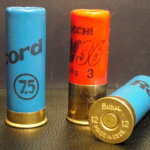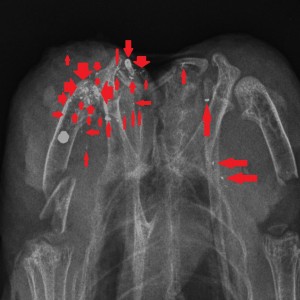 It’s apparently GB Game Week (#GBGameWeek) where the shooting industry tries to persuade us all to eat game meat. Although I am veggie for four days a week, the freezer has quite a lot of venison in it – and very enjoyable it is too. But I know where that venison comes from, it’s shot in Scotland and with copper bullets – there is no chance of there being anything other than traces of toxic lead in it.
It’s apparently GB Game Week (#GBGameWeek) where the shooting industry tries to persuade us all to eat game meat. Although I am veggie for four days a week, the freezer has quite a lot of venison in it – and very enjoyable it is too. But I know where that venison comes from, it’s shot in Scotland and with copper bullets – there is no chance of there being anything other than traces of toxic lead in it.
I’m surprised that our forestry services, in Scotland and England, don’t market their venison quite aggressively as ‘lead-free’ or at least shot with ‘non-toxic’ ammunition. This would

help differentiate the market and give choice to consumers. Venison is at the lower end of lead content even when shot with lead bullets because deer are big, they are often shot in the head and those two things mean that the tiny shards of lead that spread through the carcass (that’ll be meat when it lands on your plate) don’t get to every part of the animal.
But small game – Pheasants, partridges, Red Grouse and ducks are different. Shot with pellets, the pellets, if lead, deform as they pass through the flesh (that’ll be meat when it’s on your plate) of the animal and shed tiny shards. And pellets that hit bones do even more of this. The lead fragments are tiny – you can spit out the whole pellets but you’ll not notice the tiny fragments, but they are there as X-rays show, and they are lead, and lead is a poison.
Lead isn’t good to fling around the environment or to ingest – which is why many countries already, and the number will grow rapidly over the next few years for sure, are restricting or banning the use of lead ammunition in hunting, particularly if the quarry enter the human food chain.
There’s a big literature on the subject (see here, here and here just for starters). The first of those links goes to a report produced in 2015 for Defra which recommended the phasing out of lead ammunition on human health and environmental grounds but the utterly hopeless Liz Truss sat on the report for a year and then rejected it while David Cameron was resigning as Prime Minister – a case of a good day to bury ridiculous government decisions?
So, this week is GB Game Week where we are all encouraged to scoff game meat – and the shooters, and most of the restaurants selling game meat, and the posh chefs selling game cookery books, won’t ever mention lead in the food you might be tempted to eat.
They also won’t mention the Food Standards Agency advice which can be found here and which warns against eating too much lead-shot game meat.
Rather strangely though, the FSA isn’t reminding people of its advice on not eating too much game meat in GB Game Week despite the fact that their advice is very rarely accessed by the general public. Why not? Might it be because the chair of the FSA owns a grouse moor? And funnily enough, Mrs Hancock’s husband’s grouse moor is reported to be the the location on which a Hen Harrier disappeared recently. Small world isn’t it? Other explanations are available but it doesn’t look very good when the government’s food agency remains silent about toxic ammunition in food at a time when the shooting industry is ramming it down people’s throats – does it?
[registration_form]
Mary Berry never mentioned lead while cooking pheasant last night!!
I’m hoping that somebody can answer this for me.
We know that grouse eat grit to aid digestion, so is it not possible that they pick up lead shot as grit, since so much is blasted into the countryside? And if that is the case, then wouldn’t grouse and other game meats be even more poisonous?
Right or wrong? I really don’t know.
Dick Potts mentions a similar concern for Grey Partridges in his New Naturalist book. They apparently mistake the leads pellets for seeds. Casseroling or stewing them would no doubt help to leach it out into the food that ends up on your plate.
I’m not an avian pathologist but……surely ingestion of lead by grouse or partridge would cause similar problems to those found in swans etc and be readily identifiable?
Paul – must be possible that they pick up grit but it can’t mean that they are ‘even more poisonous’ than the levels that have been measured in them.
Can anyone locate the original 2012 FSA report on lead that they refer to in their current advice? Seems mighty hard to find on their website. Almost as if they’re trying to bury it.
This one?:
http://www.leadammunitiongroup.org.uk/wp-content/uploads/2015/07/Risk_assessment_for_lead_in_wild_game.pdf
Hidden at the top of Google search result
https://www.food.gov.uk/sites/default/files/776-1-1353_FS421005_Habits_and_behaviours_of_high-level_consumers_of_lead-shot_wild-game_meat_in_Scotland_FINAL.pdf
That’s the one thanks Filbert.
No link apparent on the FSA website though. Odd.
And when I search Google with “FSA lead report” the report doesn’t obviously come up.
What search terms did you use?
And does anyone know the basis for Andrew Gilruth’s claim that bread, vegetables and water “provide the most lead in our diet”?
HW – I searched on: 2012 FSA report on lead
Top of search result: Lead shot game – Food Standards Agency link to: Advice to frequent eaters of game shot with lead. At 4th paragraph copied:”FSA in Scotland and published in 2012″ and pasted into Google search
Top of search result: the link I posted earlier. That was earlier – now it doesn’t appear at all. Google moves in mysterious ways and maybe FSA do too
I find all of this quite extraordinary,once one has seen the X rays of shot birds with all those tiny tiny fragments of lead within the flesh why on earth would you still want that eating experience. Yes in the past I have eaten lead shot game and have on the odd occasion thought it tasted metallic–now I know why!
“GB Game week” should perhaps be subtitled play “Russian roulette with your blood lead levels” you never know it might make a permanent difference to your well being!
Not sure what you call people who continue to eat lead shot game regularly ( other than poisoned) idiots, dullards, gamblers or masochists.
Mark, thanks for highlighting the fact that deer culled by FC in England (and it sounds like Scotland have gone over too – I didn’t know that) are shot with copper bullets and, of course, RSPB were the leaders in this, weren’t they ?
I suspect FC is keeping its head down because of the howls of fury that might come from some staunch Government supporters if it were too widely publicised.
You say that deer are lower risk than small game, but I have to say that despite having worked in this area for over 40 years I was taken aback by the X rays you showed a while back – I was labouring under the naïve assumption that the bullet stayed whole once it hit the deer – the way it fragmented throughout the area hit was a revelation. And whilst head shots are acceptable, in my experience it is a heart shot that is recommended so the fragments will scatter into edible parts of the body.
Roderick you are correct, a heart or even better a lung shot, is preferable to one aimed at the head in most circumstances.
The bullet passing through the rib- cage should, in theory, have minimal impact on the end product.
I have processed hundreds of deer shot in this manner, and would imagine, though I stand corrected, that the bulk of any fragments are contained in the ribs, or the gralloch, neither being prime cuts.
Some years ago I was at a raptor conference, I can’t remember where, somebody from the California Condor project was speaking.
Obviously the lead poisoning aspect was covered in some detail, and it set me thinking on the way home, about the many thousand Red Deer grallochs left on the hill in Scotland.
I would have thought, in my ignorance, that a serious effect on breeding Golden Eagles would have come to light by now, or has it been masked by something else, or have I missed something?.
Here’s a couple to be going on with:
“Sublethal Lead Exposure Alters Movement Behavior in Free-Ranging Golden Eagles.”
“Our study highlights lead exposure as a considerably more serious threat to wildlife conservation than previously realized and suggests implementation of bans of lead ammunition for hunting.”
https://www.ncbi.nlm.nih.gov/pubmed/28414429
“Excessive lead burden among golden eagles in the Swiss Alps”
http://iopscience.iop.org/article/10.1088/1748-9326/10/3/034003/pdf
Thanks I will check those out.